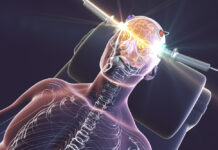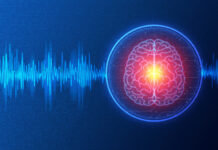Dr. John Read and Chelsea Arnold have recently conducted an updated search to examine the efficacy of Electroconvulsive therapy (ECT) for depressive symptoms. Their results, set to be published in Ethical Human Psychology and Psychiatry, found little to no evidence that ECT was more effective than placebo during treatment and no long-term evidence supporting the use of ECT post-treatment for either depression or suicide prevention.
“There is still no evidence that ECT is more effective than placebo for depression reduction or suicide prevention,” the authors write. “Given the well-documented high risk of persistent memory dysfunction, the cost-benefit analysis for ECT remains so poor that its use cannot be scientifically, or ethically, justified.”

ECT involves the administration of electric currents to the brain in order to induce a brief seizure in hopes of ameliorating symptoms of depression and other presenting problems. The procedure has been the topic of significant controversy as people question whether or not these outcomes are achieved, if research supports long-term benefits, and if the costs outweigh any of the proposed benefits. Specifically, concerns have arisen around the risk that ECT may cause brain dysfunction and increase the risk of mortality.
Whether or not the desired outcome is achieved has been challenged by findings from 70 years worth of research on ECT for depressive and psychotic symptoms. This systematic review found only 10 studies comparing ECT to a placebo treatment. Six of those studies found ECT offered short-term benefits, but this evaluation was sometimes from the perspective of the psychiatrist rather from client report. The remaining four found no difference.
In these 70 years, only four studies have examined the long-term benefits of ECT, and results indicated no difference between ECT and the placebo treatment. The review also found that ECT has not been found to prevent suicide.
Considering the valued principle of evidence-based medicine widely endorsed by medical practitioners, Read and Arnold investigated whether there were any recent additions to the literature supporting the use ECT.
They conducted an updated electronic search of research comparing ECT to SECT (the placebo treatment) for depressive symptoms in adults between the years 2010 and 2016. This review included original studies which reported depression scores at two or more points in time through an empirically validated measure. The researchers excluded case reports, review articles, letters to the editor (without empirical research), studies featuring duplicate data, studies conducted on animals, and non-English studies.
The search results yielded 2,513 studies, of which, 91 met the inclusion criteria. None of these studies were placebo-controlled studies comparing ECT and SECT for depression, and only one attempted to investigate its efficacy.
“There has been only one study that aimed to directly investigate the efficacy of ECT in depression through comparison with another treatment modality. It had no placebo control group and no data beyond the end of the treatment period,” write the authors.
The purposes of the remaining studies varied and included investigating mechanisms of action of ECT, predictors of response, comparisons of ECT to other forms of treatment, the different parameters of ECT delivery, the different anesthetic agents used, the effects of ECT adjuncts, naturalistic studies, and other aims. The authors point out that many ECT-related studies are conducted with the unsupported assumption that ECT works.
Studies that reported a decrease in depressive symptoms related to ECT did not exclude confounding non-ECT factors that may have contributed to the improvement. Without a placebo control group, both short and long-term studies claiming benefits derived from ECT cannot be empirically supported.
None of the studies examined whether ECT prevents suicide, another professed use of ECT that continues without sufficient supporting evidence.
“In other medical disciplines, this state of affairs might have led either to a phasing out of the procedure or at least to a plethora of studies seeking to determine whether the treatment in question does actually work. This is not the case for psychiatry and ECT,” note Read and Arnold.
Not only is the lack of evidence supporting the use of ECT alarming, but concerns abound regarding the harm ECT may be causing.
“Such continued failure to produce any evidence would be of less concern if there were not robust evidence that ECT causes long-lasting memory loss for a significant proportion of recipients.”
Significant memory loss and cognitive effects following ECT have been reported in studies examining user’s experiences of the procedure, finding that symptoms of memory loss occur in 51-79% of participants. This memory loss, often qualified as “persistent or permanent,” is related to the number of ECT administrations received, more likely to occur in bilateral ECT (the most common form), and disproportionately affects the two main demographic groups receiving ECT: women and older adults.
“We should, meanwhile, remain cognizant of the fact that the archetypal ECT recipient remains, as it has for decades, a distressed woman more than 50 years old.”
In 2004, New Zealand’s Ministry of Health reported that “ECT may permanently affect memory and sometimes this can be of major personal significance,” and they call attention to the “slowness in acceptance by some professional groups that such outcomes are real and significant in people’s lives.”
Dr. Read added, “The dwindling number of psychiatrists who continue to use this outdated, ineffective and dangerous procedure are simply not adopting an evidence-based approach to their clinical work.”
Despite the tapering of ECT use in other countries, the United States continues to remain a high user, particularly in the state of Texas where ECT administration has increased. In fact, at the beginning of last year, the U.S. Food and Drug Administration’s movement to reclassify ECT from a high risk to a low-risk treatment was supported by the president of the American Psychiatric Association, Dr. Renée Binder.
Read and Arnold conclude with a statement from a 2010 literature review (also authored by Read and co-author Bentall) which remains relevant:
“The continued use of ECT therefore represents a failure to introduce the ideals of evidence-based medicine into psychiatry. This failure has occurred not only in the design and execution of research, but also in the translation of research findings into clinical practice. It seems there is resistance to the research data in the ECT community, and perhaps in psychiatry in general.”
****
Read, J., & Arnold, C. (2017). Is Electroconvulsive therapy for depression more effective than placebo? A systematic review of studies since 2009. Ethical Human Psychology and Psychiatry, 19, 5-23. (LINK)















In terms of biology, recently, the NMDA receptor has been imaged using X-ray crystallography – as far as I know – for the first time ever, showing that the receptor moves and this movement generates an electrical field. The inference that is being drawn from this, is that this movement or lack there of is related to neurological and psychiatric conditions:
https://www.youtube.com/watch?v=33bYfEg22MU
Feel free to shoot me down 😉
Report comment
The only thing ECT is effective at is causing craniocerebral trauma. It causes brain damage with its memory loss, cognitive dysfunction, personality changes.
It is electrical injury to the neurological system paired with grand mal seizures. It is straight up torture, a human rights violation.
WHAT is being done to see that it is banned? Seriously.
Report comment
Of course it works for depression. People become suicidal when they realize how much of themselves and their lives they have lost because of ECT. They kill themselves – and then there are fewer depressed people.
Seriously, I personally knew four people who killed themselves as a direct adverse effect of ECT, I knew one woman who died of a heart attack shortly after ECT. I saw one woman being resuscitated after her ECT ‘therapy’.
Report comment
Why is there such a profound disinterest in this topic? 2000 read the last article/listened to the podcast. Only 19 comments.
This article? 3 comments.
There should be a massive outcry from the public and the medical community regarding the findings of these studies. Why does no one care?
Report comment
Perhaps the lack of comment here is related to the recent very sad news from MIA? And more generally people have more experience of drugs than ECT.
Report comment
There is a lack of comment on this topic on a regular basis.
A recent petition to ban shark fin soup in Toronto restaurants garnered 11,000 signatures. A petition revisiting the ban on pit bulls garnered 300,000 signatures. The petition to ban electroshock in Canada? 25 signatures. We are talking brain damaging and trauma done to human beings and nobody cares? Because they are more familiar with sharks and dogs?
A young mother from Colorado took her life in July after ECT destroyed her memory and cognition. There were no outpourings of outrage; the blame wrongly ascribed to mental illness.
People were not so familiar with lobotomies, but were outraged at the practice.
ECT is simply electrical lobotomy. People are opposed to shocking of prisoners of war and it is deemed as torture, but it is ok to administer it to pregnant women, the elderly, and any other poor person who falls into the clutches of the lunatics administering ECT?
Report comment
Maybe it’s because the lame-stream media either completely ignores “ECT”/Electro-Cution Torture, or else sugar-coats & whitewashes it…..
It’s just one more *LIE* of the pseudoscience drug racket and means of social control known as psychiatry. Look how “successful” psychiatry is!
But, as far as I know, the FDA still lists ECT as “unproven” and “experimental” technology. (Please God, don’t tell me the FDA gave ECT full approval in the last year, and we all missed that!?….)
Sometimes, ECT **SEEMS** to work in the short-term, but only because the victim is unable to respond with normal reactions to being tortured with electricity. The only TRUE “anosognosia” is that induced by ECT.
ECT = Electrocution Torture…..
Report comment
The useless FDA could have banned ECT after disturbing hearings in 2011. It didn’t. It stated the devices needed to be tested and then did not enforce testing.
Then it attempted to have the torture device downgraded to class II fron class III for “certain indications”. A flood of angry letters and petitions followed and a year later, nothing from these idiots, even as the science continues to expose ECT for the useless but dangerous torture that it is.
Report comment
The primary function of today’s “mental health industry” is covering up child abuse, according to their own medical literature.
Today, “the prevalence of childhood trauma exposure within borderline personality disorder patients has been evidenced to be as high as 92% (Yen et al., 2002). Within individuals diagnosed with psychotic or affective disorders, it reaches 82% (Larsson et al., 2012).”
And it’s been medically pointed out that the psychiatric drugs do, indeed, create the symptoms of today’s DSM disorders. The ADHD drugs and antidepressants create the symptoms, and the adverse drug effects of those drug classes create the symptoms, of “bipolar.” And such medical misdiagnoses on a massive scale, even according to the DSM-IV-TR, have resulted in a completely iatrogenic “childhood bipolar epidemic.”
http://www.alternet.org/story/146659/are_prozac_and_other_psychiatric_drugs_causing_the_astonishing_rise_of_mental_illness_in_america
And the “bipolar” as well as the “borderline” and other “psychotic and affective disorder” DSM drug cocktail recommendations do advocate combining the antidepressants and/or the antipsychotics (aka neuroleptics). Despite the medical literature confessing such unethical prescribing being able to create both the negative symptoms of “schizophrenia” and the positive syndromes of “schizophrenia,” via both neuroleptic induce deficit syndrome and the antidepressant or antipsychotic induced anticholinergic toxidrome.
https://en.wikipedia.org/wiki/Neuroleptic-Induced_Deficit_Syndrome
https://en.wikipedia.org/wiki/Toxidrome
Report comment
But no doubt, the psychiatric industry wants to cover up the failure of their drugs, and hide the medically known psychiatric drug induced, iatrogenic nature of their DSM disorders. And since today’s psychiatric industry is all about erasing the memories of child abuse victims, or those with legitimate medical evidence of child abuse or easily recognized iatrogenesis. Of course the psychiatric industry wants to utilize ETC to destroy the memories of all those who they have committed crimes against.
Report comment
Thanks John for your research and podcast. Yesterday was the 140th anniversary of the birth of Ugo Cerletti. And I missed it.
On the subject of ECT research and perhaps psychiatric research as a whole I have been wondering if there is any one piece of research that has actually led to improvements for people having treatment?
Report comment
Wait, you mean that inducing a seizure by electrocuting someone’s head DOESN’T make them feel better and has a high risk of doing permanent damage? Whoda thunk it???
Report comment
Seems so obvious, but the lies, misinformation, and propaganda continue to draw in sick and vulnerable people.
With high profile doctors like David Healy promoting this lunatic barbaric assault in spite of and ignoring the science and evidence, how will ECT ever be stopped? Peter Breggin has tried his best, but where is the support of mainstream medicine, ethical psychiatrists, neurologists? Everyone is looking the other way. Electrical injury expert doctors testify to devastating neuro cognitive and psychiatric problems springing from accidental electrocution, but refuse to testify to ECT injuries, where the electrocution is to the head and repeated multiple times. Why is that do you think that is?
Neurologists and neuropsychs are completely unwilling to write reports that state ECT has been the cause of the injuries and deficits. They are complicit in covering for the doctors brain damaging people.
Report comment
Professional Development. I think all promoters of ECT should experience at least 25 bilateral ‘therapies’ before they treat patients. I sit here at the computer and my legs quiver just as they did during ECT 13 years ago. I was not depressed. I was misdiagnosed.
Report comment
I have a close friend who had some ECT years ago. It has NOT helped, at all…. And yes, sometimes, she will “space out”, in a way that she denies, but pretty much everybody who knows her recognizes. Except the shrinks, who remain in DEEP DENIAL…..
It’s beyond sad….
Report comment
FYI the publisher has made the article freely available to read: https://doi.org/10.1891/1559-4343.19.1.5
Full disclosure, I am the Executive Editor of the Journals Department.
Report comment
I asked scholar.google.com about this…
It has been known and proven since 1951 ! that ECT cerebral trauma is associated with ACTH and Glucocorticoid hormones release.
Also known the fact that glucocorticoids intake may help depressed persons short term .
So I say ECT practice is completely ridiculous in its theory and a criminal practice: I’d tell these criminals: “Just give prednisolone to your unlucky patients if your are too mediocre a human being to help them otherwise and spare them the permanent brain damage and death risk.”
[1] Adrenocortical responsibility in relation to psychiatric illness and treatment with ACTH and ECT. (PMID:14897894)
REISS M , HEMPHILL RE , EARLY DF , MAGGS R , COOK ER , PELLY JE
Journal of Clinical and Experimental Psychopathology [01 Jul 1951, 12(3):171-183]
http://europepmc.org/abstract/med/14897894
[2] Effects of electroconvulsive therapy on neuropsychological function and circulating levels of ACTH, cortisol, prolactin, and TSH in patients with major depressive illness
Acta psychiatrica scandinavia, December 1985
http://onlinelibrary.wiley.com/doi/10.1111/j.1600-0447.1985.tb02651.x/full
My article in french:
http://depsychiatriser.blogspot.fr/2017/08/ect-une-procedure-completement-ridicule.html
Report comment
Bonnie Burstow’s in the news again
For people concerned about the horror of psychiatry and especially people concerned about the horror of electroshock, please know that an anti-ECT campaign is just kick-starting. And those of us involved could use help. If you know of anyone who has had electroshock in Canada over the last 2 years, and is interested in getting involved in a class action suit, please encourage them to get in touch with me. Also, when it comes out in a few weeks, please read my novel The Other Mrs Smith, that centres on ECT, and blog about it, write reviews about it, and bring it to other people’s attention. (I’ll let you know just as soon as it is out, which will be before the end of the month.) If in the Toronto area, you might also want to come to the book launch (Nov 3, 12th Floor OISE, 252 Bloor West, Toronto, 5:30). Please see amended flyer attached.
https://scontent.fykz1-1.fna.fbcdn.net/v/t1.0-9/22221519_10159490311810444_7965703160791676408_n.jpg?oh=7271c43b764e92fee4315c3a57f89d1b&oe=5A44C956
Report comment
In 2010 while organising the May 2015 anti-ECT protest in Melbourne, Australia – I met 10 people, none of whom knew each other, who had relatives, friends or acquaintances who had received ECT. Here are their details:
1. A saleswoman at the art shop where I purchased material for posters – when I told her what they were for she offered to pay for all the materials – her 21 year old son, an honours university student, had had ECT and some months later he killed himself – the reason “I can no longer learn anything”.
2. A friend I played tennis with – her brother killed himself between ECT#3 and ECT#4, while in a private hospital – he had begged them to stop, but was threatened with an Involuntary Treatment Order that he feared would destroy his career. (Hobson’s Choice.)
3. An acquaintance from another tennis club – her mother had killed herself following ECT at a well known private hospital where it was common for physical and emotional coercion to occur.
4. My GP – her mother died within a few months of ECT, the doctor was sure it contributed to her death as she became a virtual `zombie’.
5. A saleswoman in a bookshop, where I asked if I could put a pamphlet in her window. – Her mother’s life had been ruined by ECT, she’d been very creative and has `lost all of that’.
6. The sound engineer I hired equipment from for the protest – A close friend’s life was ruined by ECT
7. A saleswoman where I bought equipment for the Protest – a colleague’s sister’s life had been ruined by ECT
8. A very old man at a BBQ – his wife had been ruined by ECT
9. My neighbour – a good friend who had been an outgoing, life of the party woman, had become a recluse and saw no one.
10. A man in a shop – a good friend had done really well following ECT.
Of 10: 4 dead – 5 wrecked lives – 1 good outcome. 9:1 Not the best odds, I’d say.
What to do – I’ve said over and over again – prove the brain damage, get the neurologists onside – cost the government money by demanding rehab – once you establish the brain damage you can SUE in class actions – without this – we’re preaching to the choir.
They have MONEY and they use it for protracted PR campaigns – we don’t and don’t. We’re just a protest movement of radical ratbags, they’re PROFESSIONALS, DOCTORS, the nouveau saints with the government’s ear.
The other problem is the victims themselves. a) the injury causes apathy, and disability; b) some families like the quiet, uncomplaining zombie; c) education and culture say the `doctor knows best’ and he wouldn’t hurt me. Then we have a) institutional denial by the authorities, financial & cognitive dissonance for psychiatrists & hospitals, ignorance for government officials; and b) lack of awareness from the rest of the medical profession and the public.
Maybe history can help, e.g. How did Insulin Coma get stopped? It killed people and was EXPENSIVE. Just possibly making it expensive, by alerting the authorities to the scam, flooding the rehab facilities, and ltigation of the government for allowing it, and the doctors for prescribing it. Make it PRACTICAL not emotional. But remember ECT is what keeps many of those small psych hospitals in the black- so good luck.
Report comment
Thank you for your post. Yes, the odds are bad. You might be interested in the new website http://www.ECTstories.com which is still in need of more stories.
Report comment
But Insulin Coma WAS abandoned – in the early 1970s in the hospital where I worked, ECT WAS on the way out – a 1000 bed hospital rarely had more than 6-8 ECT patients a week and by 1974, the ECT unit was sometimes closed for weeks at a time. The COMEBACK was when the private hospitals opened in the late 70s + ECT was cheap to use (unlike Insulin Coma), the government subsidised it so they could charge more, brain damaged people don’t complain much, and they always came back for more because it did nothing for their depression. That was when the PR began in earnest. The NEW IMPROVED ECT no longer caused brain damage etc etc. In fact NOTHING new has occurred since the 1960s, FIFTY years ago. The ULTRA BRIEF PULSE ECT was introduced in the 1960s and abandoned because it was no good – it was RE-introduced in the 1990s as the NEW ECT. They’d moved the deck chairs on the Titanic and said, “see doesn’t that look better?”
Like everything in psychiatry, it’s a scam and somehow this MUST be exposed.
I once replied to a cynical touting for ECT business by an Irish psychiatrist, presented as information, and suggested that the amount of money ECT would be making for his hospital might be his motivation – within half an hour the comments section was closed a day before normal. !!!! THAT is what we have to do.
Report comment